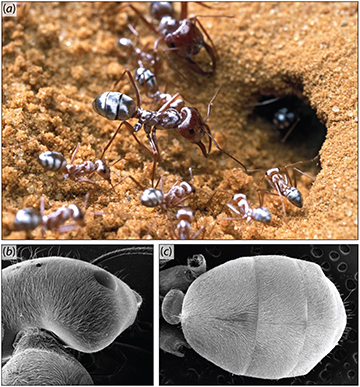
(a) In full sunlight, silver ants show a metallic sheen that justifies their name. (b, c) The hairs covering the dorsal side of the ants’ head, thorax (b) and abdomen (c) follow the cuticle’s curvatures. Credit: P. Landmann, Willot et al.
Scientists in Belgium used optical ray-tracing models and attenuated-total-reflection experiments to find that Saharan silver ants (Cataglyphis bombycina) are able to tolerate extremely high desert temperatures because their body hair causes total internal reflection of sunlight (PLOS ONE, doi: 10.1371/journal.pone.0152325). The geometric and high-reflection properties of the hair also give the ants their distinctive silvery color. Team lead and coauthor Serge Aron, Université libre de Bruxelles, says “to the best of our knowledge, this is the first time that total internal reflection is shown to determine the color of an organism.”
Previous work revealed that body hairs on C. bombycina help prevent the insect from overheating and give it a bright color, but until now, the optical mechanisms responsible for these characteristics were unknown. Aron and his colleagues examined silver-ant hairs under a scanning electron microscope and traced the path of light rays aimed at individual hairs. They found that unlike their fellow arthropods, which have cylindrical or plate-shaped body hairs, C. bombycina hair is triangular in cross-section, like a prism, with two corrugated surfaces. Light rays directed at an individual silver-ant hair undergo total internal reflection, bouncing off the bottom plane of the hair and giving it a mirror-like sheen.
Next, the Belgian team compared the body temperatures of normal “hairy” ants and “shaved” ants under simulated sunlight (visible and near-infrared wavelengths). They found that the hairy ants were able to maintain body temperatures up to 2 °C cooler than their hairless counterparts.
Authors of the PLOS ONE paper say that in addition to optimizing the backscattering of light and giving the ant its silver color, the triangular form of the hairs may also play a role in communication and camouflage.
